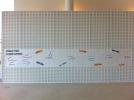What we did at Creative Computing 2010
Contributed by
Karen Brennan, July 29, 2010
Last year, I shared a story about our experiences hosting Creative Computing, a Google-sponsored workshop that is a part of the CS4HS network of events. In the story, I gave a brief overview of the workshop activities and discussed participant reactions to the workshop.
We were fortunate to again receive funding to host our Creative Computing workshop. In this year’s story, I’m going to focus on the details of the event, by providing an outline of each session and its activities – and links to resources we developed in the process.
Thursday morning: Introduction
- We did group introductions and icebreakers.
- Mitch gave a talk about the big ideas being explored throughout the workshop: computational concepts, computational practices, and learning approaches.
- Participants did an introductory hands-on activity called “Surprise, me!” – creating projects with something surprising happening to them. Mitch and I showed very little of Scratch (just demonstrating how to make the cat dance back and forth) before launching them into this activity.
- Participants used the reflection wall to share their reactions to the big ideas from Mitch’s presentation.
- Participants went on a tour of the Media Lab and heard about the work of four different research groups.
Thursday afternoon: Art/Music Workshop
- Fernanda Viegas and Martin Wattenberg gave a talk about information visualization, including their Many Eyes work and the connection between visualization and the arts.
- Participants did a CS-unplugged activity to explore the computational concept of sequences. We gave one person a secret picture that they described step-by-step for others to recreate.
- Participants did a short activity with Scratch that explored visual constraints, creating projects that included an orange square and purple circle. I started the activity by quickly making an “Orange square, purple circle” project.
- Participants did another short activity with Scratch that involved making a themed interactive collage. Mitch started the activity by making an interactive collage about the first man on the moon.
- Participants used the reflection wall to share something they had learned during the first day and something they hoped to learn the next day.
Friday morning: Stories Workshop
- Kevin Brooks gave a talk about storytelling and led us through several storytelling activities.
- Participants did another computer-less activity to explore the computational concepts of parallelism and events. We used cut-outs of Scratch blocks to “program” participants: one person doing one thing, one person doing two things at once, two people doing something simultaneously, one person triggering another person’s actions.
- Participants did an extended collaborative story-making activity. Each participant started a story and worked on it for 15 minutes. After the 15 minutes, each participant rotated to a new computer, inheriting the story there and extending it for 10 minutes. After another rotation, everyone returned to their original computer to see what had been created. Mitch and I started the activity by creating our own pass-it-on story.
- We did a gallery walk of the stories to see the variety of stories that had been created.
- Mitch then shared some stories from the Scratch website, as found in the Scratch Tours. We also distributed a handout with story starter ideas.
- Participants used the reflection wall to share their thoughts about how the collaborative story-making activity had been structured.
Friday afternoon: Sensing Workshop
- Marina Bers gave a talk about robotics in early childhood education.
- Rather than start with an explicit discussion about computational concepts (in this session, conditionals and operators), participants did an activity focused on the computational practices of testing and debugging, with participants debugging short Scratch programs.
- Participants did a series of short activities exploring WeDo components. Participants had handouts with sample WeDo projects for inspiration.
- Participants then transitioned to a larger WeDo project. Mitch and I showed a couple of sample WeDo/Scratch projects and had LEGO WeDo building instructions for building particular models available.
- Participants shared their projects with each other and used the reflection wall to share their thoughts about the affordances of the tangible experience.
Saturday morning: Games Workshop
- Eric Klopfer gave a talk about games and learning.
- Mitch introduced the concept of variables by demonstrating how to add a score to the Fish Chomp game that is included in the Scratch sample projects. I then showed some starter game projects.
- Participants used the rest of the workshop time to design their own games with Scratch, which ended in a project exhibition.
Saturday afternoon: Conclusion
- I gave a short talk about ScratchEd and what other teachers are doing with Scratch in the classroom.
- Participants split into 5 groups and discussed the following questions: What are the types of things you have already been doing with Scratch in schools? What are the ideas/activities that you’ve done in the workshop that have inspired you? How might these translate to your teaching practice? What are the challenges? What questions remain?
- Mitch and I used the reflection wall to record the themes that emerged from the participants’ discussions.
Other Files:
Links:



